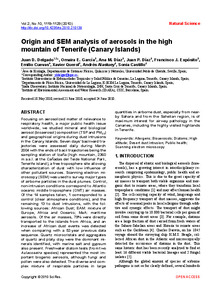Por favor, use este identificador para citar o enlazar este ítem:
http://hdl.handle.net/20.500.11765/409
Origin and SEM analysis of aerosols in the high mountain of Tenerife (Canary Islands)
Registro completo de metadatos
| Campo DC | Valor | Lengua/Idioma |
|---|---|---|
| dc.contributor.author | Delgado, Juan Domingo | - |
| dc.contributor.author | García Rodríguez, Omaira Elena | - |
| dc.contributor.author | Díaz Rodríguez, Ana María | - |
| dc.contributor.author | Díaz González, Juan Pedro | - |
| dc.contributor.author | Expósito González, Francisco Javier | - |
| dc.contributor.author | Cuevas Agulló, Emilio | - |
| dc.contributor.author | Querol, Xavier | - |
| dc.contributor.author | Alastuey, Andrés | - |
| dc.contributor.author | Castillo, Sonia | - |
| dc.date.accessioned | 2015-12-09T08:35:46Z | - |
| dc.date.available | 2015-12-09T08:35:46Z | - |
| dc.date.issued | 2010 | - |
| dc.identifier.citation | Natural Science. 2010, 2(10), p. 1119-1129 | es_ES |
| dc.identifier.issn | 2150-4091 | - |
| dc.identifier.issn | 2150-4105 | - |
| dc.identifier.uri | http://hdl.handle.net/20.500.11765/409 | - |
| dc.description.abstract | Focusing on aerosolized matter of relevance to respiratory health, a major public health issue worldwide, we studied mineral and biological aerosol (bioaerosol) composition (TSP and PM2.5) and geographical origins during dust intrusions in the Canary Islands. Seven days’ back- ward trajectories were assessed daily during March 2004 with the ends of back trajectories being the sampling station of Iza?a (high moun- tain, 2360 m a.s.l. at the Ca?adas del Teide National Park, Tenerife island), a free troposphere site allowing characterization of dust with low influence of other pollutant sources. Scanning electron microscopy (SEM) was used to survey major types of airborne particles in the dust plumes. Control, non-intrusion conditions correspond to Atlantic oceanic middle troposphere (OMT) air masses. Of the 14 samples taken, 1 corresponded to a control (clear atmosphere conditions), and the remaining 13 to dust intrusions, with the following sources: African Dust; EAM: mixture of Europe, Africa and Oceanic; MaA: maritime aerosols. Of the air masses, 79% were directly transported to the islands from Africa, and an increase of African dust events was detected when comparing with a 52-year previous data sequence. Quartz microcristals and aggregates of quartz and platy clay were the dominant minerals identified, with marine salt and gypsum also present. Freshwater diatom tests (from two Aulacoseira species) represented the most important biogenic aerosols, although fungi and pollen were also detected. The diverse and complex mixture of respirable particles in large quantities in airborne dust, especially from nearby Sahara and from the Sahelian region, is of maximum interest for air- way pathology in the Canaries, including the highly visited highlands in Tenerife. | es_ES |
| dc.description.sponsorship | We acknowledge to the MEC (Ministry of Education and Science, Spain) and F.E.D.E.R. founds (E.U.) for the economical support of the following projects: CGL2005-03428-C04-02, CGL2007-66477-C02-02/CLI, CGL2008- 04740 and PI042005/033. | - |
| dc.format | application/pdf | - |
| dc.language.iso | eng | es_ES |
| dc.publisher | Scientific Research Publishing | es_ES |
| dc.subject | Allergens | - |
| dc.subject | Bioaerosols | - |
| dc.subject | Desert dust intrusion | - |
| dc.subject | Public health | - |
| dc.subject | Bioaerosoles | es_ES |
| dc.subject | Alérgenos | es_ES |
| dc.subject | Partículas de arena | es_ES |
| dc.title | Origin and SEM analysis of aerosols in the high mountain of Tenerife (Canary Islands) | es_ES |
| dc.type | info:eu-repo/semantics/article | es_ES |
| dc.relation.publisherversion | https://dx.doi.org/10.4236/ns.2010.210139 | es_ES |
| dc.rights.accessRights | info:eu-repo/semantics/openAccess | - |
| Colecciones: | Artículos científicos 2010-2014 | |
Ficheros en este ítem:
| Fichero | Descripción | Tamaño | Formato | ||
|---|---|---|---|---|---|
| NS20101000010_4998507... | 4,29 MB | Adobe PDF |  Visualizar/Abrir |
Este ítem está sujeto a una licencia Creative Commons Licencia Creative Commons






